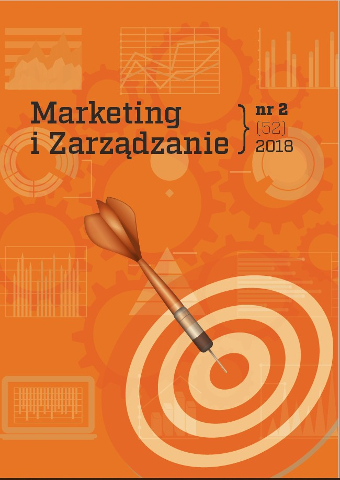
ISSN: 2450-775X
OAI
DOI: 10.18276/miz.2018.52-11


Issue archive /
nr 2 (52) 2018
Wizerunek miasta w ocenie mieszkańców i jego determinanty
(The Image of the City in the Eyes of Inhabitants and its Determinants)
| Authors: |
Agata
Niemczyk
Uniwersytet Ekonomiczny w Krakowie, Wydział Zarządzania |
| Keywords: | city image demographic and social features survey |
| Data publikacji całości: | 2018 |
| Page range: | 13 (115-127) |
| Klasyfikacja JEL: | Z12 Z32 |
Abstract
The image of the city is of a subjective nature. It is shaped by an individual and depends on their socio-demographic characteristics. Subject literature says that age and education are the main determinants of the city’s image. The objective of the paper is to present the opinion of the residents of Nowy Sącz about the image of the city. In order to achieve the main objective, the following sub-objectives has been achieved: identification of the category of the image of the city and its determinants; establishing the rating of Nowy Sącz from the perspective of its residents; recognition of the impact of socio-demographic characteristics of the respondents on the evaluation of the city’s image (with the use of non-parametric tests) and their order of priority (with Spearman’s correlation coefficient). Additionally, the image of Nowy Sącz was presented in comparison to the image of Krakow – two different cities of different character, in order to prove that one of the determinants shaping the image of the city is also the territorial unit itself. The empirical basis of conducted analyses were the findings of direct study carried out amongst the residents of Nowy Sącz and Krakow in 2017.
Download file
Article file
Bibliography
| 1. | Altkorn, J. (2002). Kształtowanie rynkowego wizerunku firmy. Kraków: Wydawnictwo Akademii Ekonomicznej w Krakowie. |
| 2. | Avraham, E. (2004). Media strategies for improving an unfavorable city image. Cities, 21 (6), 471‒479. |
| 3. | Baloglu, S., McCleary, K. (1999). A model of Destination Image Formation. Annals of Tourism Research, 26 (4), 868‒897. |
| 4. | Boryczka, E.M., Zasina, J. (2016). Dziedzictwo kulturowe i tożsamość miasta. W: A. Nowakowska, Z. Przygodzki, A. Rzeńca (red.), EkoMiasto#Społeczeństwo. Zrównoważony, inteligentny i partycypacyjny rozwój miasta. Łódź: Wydawnictwo Uniwersytetu Łódzkiego. |
| 5. | Florek, M., Zyminkowski, T.(2002). Transfer wizerunku region na wizerunki przedsiębiorstw. W: L. Żabiński, K. Śliwińska (red.), Marketing. Koncepcje, badania, zarządzanie. Warszawa: PWE. |
| 6. | Gartner, W.C. (1993). Image Formation Process. W: M. Uysal, D.R. Fesenmaier (red.), Communication and Channel Systems in Tourism Management (s. 196). New York: Haworth Press. |
| 7. | Geng-Qing Chi, C., Qu, H. (2008). Examining the structural relationships of destination image, tourist satisfaction loyalty: An integrated approach. Tourism Management, 29, 624‒636. |
| 8. | Glińska, E. (2011). Identyfikacja wyróżników tożsamości miast podlaskich – koncepcja badań. Zeszyty Naukowe Uniwersytetu Szczecińskiego, 663, Ekonomiczne Problemy Usług, 75, 35‒47. |
| 9. | Glińska, E., Florek, M., Kowalewska, A. (2009). Wizerunek miasta: od koncepcji do wdrożenia. Warszawa: ABC Wolters Kluwer. |
| 10. | Govers, R., Go, F.M. (2004). Culture identities constructed, imagined and experienced: The 3 gap tourism destination identity and image creation model. Tourism Interdisciplinary Journal, 52 (2), 165‒183. |
| 11. | Kim, S.S., Morrsion A.M. (2005). Change of images of South Korea among foreign tourist after the 2002 FIFA World Cup. Tourism Management, 26 (2), 233‒247. |
| 12. | Kotler, Ph. (1994). Marketing – analiza, planowanie, wdrażanie i kontrola. Warszawa: Gebethner i S-ka. |
| 13. | Kotler, Ph., Asplund, Ch., Rein, I., Haider, D. (1999). Marketing Places Europe. London: Prentice Hall. |
| 14. | Krysiński, D. (2013). Wszystko, co złe, to reforma. O utracie statusu miasta wojewódzkiego w dyskursie kaliszan. Przegląd Socjologiczny, 62 (4), 25‒42. |
| 15. | Lee, Ch., Lee, Y., Lee, B. (2005). Korea's destination formed by the 2002 World Cup. Annals of Tourism Research, 32 (4), 839‒858. |
| 16. | Łukowski, W. (2002). Społeczne tworzenie ojczyzn. Warszawa: Wydawnictwo Naukowe Scholar. |
| 17. | Markowski, T. (1997). Miasto jako produkt – wybrane aspekty marketingu miasta. W: T. Domański (red.), Marketing terytorialny. Strategiczne wyzwania dla miast i regionów, Łódź: Centrum Badań i Studiów Francuskich, Instytut Studiów Międzynarodowych, Uniwersytet Łódzki. |
| 18. | Milman, A., Pizam, A. (1995). The role of awareness and familiarity with a destination. The Central Florida Case. Journal of Travel Research, 33 (3), 21‒27. |
| 19. | Nawrocka, E. (2013). Wizerunek obszaru recepcji turystycznej. Podstawy konceptualizacji i czynniki jego kreowania. Wrocław: Wydawnictwo Uniwersytetu Ekonomicznego. |
| 20. | Niemczyk, A., Seweryn, R. (red.). (2018). Wizerunek miasta w aspekcie wielkich wydarzeń religijnych. Kraków: C.H. Beck. |
| 21. | Raszkowski, A. (2012). Rola wizerunku w odniesieniu do rozwoju społeczno-gospodarczego miasta. Studia Miejskie, 7, 81‒89. |
| 22. | Raszkowski, A. (2013). Marketing miejsc w kontekście wzmacniania i kształtowania tożsamości terytorialnej. Zeszyty Naukowe Uniwersytetu Szczecińskiego, 775, Problemy Zarządzania, Finansów i Marketingu, 30, 225‒234. |
| 23. | Waszczyńska K. (2014). Wokół problematyki tożsamości. Rocznik Towarzystwa Naukowego Płockiego, 6, 48‒73. |
| 24. | Zdon-Korzeniowska, M. (2009). Jak kształtować regionalne produkty turystyczne? Teoria i praktyka. Kraków: Wydawnictwo Uniwersytetu Jagiellońskiego. |